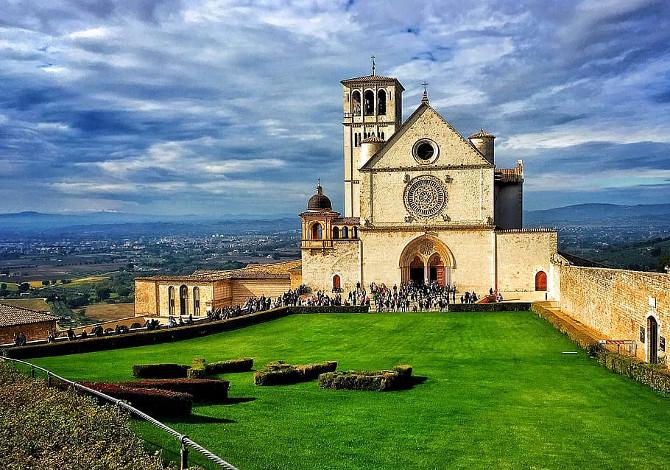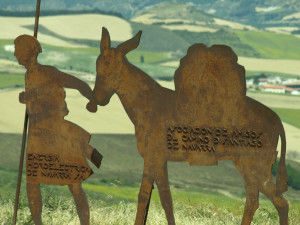I paths of Umbria they are a pleasant, slow and ecological way of learn about the green heart of Italy and its spiritual history. In fact, a large part of the paths in Umbria are linked to the figures of saints born in this region, from Way of Franciswhich in its many variants follows in the footsteps of the saint of Assisi, al Path of San Benedetto, which retraces the steps of the monk of Norcia.
And then there is a piece of Via Francigena that crosses Umbria, and still the Way of Fra’ Bernardino and other interesting itineraries both from a naturalistic point of view and from a historical, artistic and religious one.
The Paths of Umbria: on foot on the 7 paths of San Francesco and San Benedetto
In short, Umbria is the land of walkingto be covered in the traditional way, from start to finish, or to be done in fits and starts, a little at a time, dedicating a few days to this natural way of discovering our country also by crossing the borders of Umbria with Tuscany, the Marches and Lazio.
1. The Way of Francis
Il Way of Francis it’s a long journey inside the Valle Santa Rietia large plain surrounded by mountains and hills in which the saint of Assisi made three fundamental gestures in his life: it is here that in 1223 he wanted the first Crib of Christianitythis is where he wrote the rule of his Order and this is probably where he also wrote the Canticle of the Creatures.
The Camino di Francesco, 22 stages for 500 kilometres, unites i 4 Franciscan Sanctuaries of the Reatina Valley – those of Greccio,
La Foresta, Poggio Bustone and Fontecolombo – as well as touching Rieti, with its medieval historic center, lapping the Velino river and crossing Lungo and Ripasottile lakes nature reserveone of the Italian birdwatching sanctuaries. The stages of the Camino di Francesco and his life in the Holy Valley can be explored on the website www.camminodifrancesco.it
2. The Way of Francis
The other Franciscan route among the Cammini dell’Umbria, much loved and traveled by pilgrims, is the Street of Francisin this case a linear path from north to southwhich ends at the Franciscan sanctuary of La Verna, in Chiusi della Verna in the Foreste Casentinesi park, and Rome. Ideally there are 22 stages for 500 km, with two possible variants in the southern part of Assisi, the Via del Sud which crosses the Holy Valley overlapping with the stages of the Camino di Francesco and the Via di Roma which from Lake Piediluco heads to Sabina and then to the eternal city.
The stages, both on foot and by mountain bike, and any other information and recommendations can be found on the site www.viadifrancesco.it.
3. The Way of Assisi
Il Way of Assisi it is the “official” path of St. Francis and is twinned with the Camino de Santiago (of which we speak extensively here). Basically it is the organized union of a series of paths linked to the saint of Assisi and to Sant’Antonio starting fromhermitage of Sant’Antonio di Montepaolo in Dovadolain the province of Forlì, and point towards Assisi passing through the Hermitage of Camaldoli (where they partially cross the path of the Alta Via dei Parchi and also the Cammino di Dante), la Verna (one end of the Via di Francesco) and Gubbio, the town that was the first to welcome the Poverello at the beginning of 1207.
In all they are 285 km, ideally divided into 13 stages: description of the stages, information on the support points, history and any other information can be found on the site www.camminodiassisi.it.
4. The Franciscan Way of the Marca
Il Franciscan Way of the Marca it is another of the Franciscan paths, this time on the trail of the paths that the Saint took to preach his rules in what is now the Marche. Also for the Franciscan Way of the Marca the epicenter is Assisi, and the arrival is in Ascoli Piceno.
In the middle 167 km on the paths of the Umbrian-Marche Apennines and the Sibillini National Park, crossing villages and towns of Franciscan spirituality, with well 3 structures for the reception of pilgrims, in Comunanza, Venarotta and Ascoli Piceno. Stages, descriptions and information on the site www.camminofrancescanodellamarca.itwhich also organizes 8-day group walks with guides and logistical support through the Cammini della Marca association.
5. The Way of the Franciscan Protomartyrs
The Franciscan Protomartyrs are Saints Berardo, Ottone, Pietro, Accursio and Adiuto, the first martyrs of the Franciscan Order in whose footsteps the Path of the Franciscan Protomartyrs, a 100 km route that connects the birthplaces of the Protomartyrs from Terni to Amelia. The crux of this journey is the Sanctuary of the Church of Sant’Antonio da Padova in Terniwhere the remains of five saints are kept.
Information on the stages, on the route, on the events of the Protomartyrs and on the historical, artistic, cultural and naturalistic aspects of the territory crossed can be found on the website www.camminoprotomartiri.it
6. Path of Benedict
The Cammino di Benedetto is the walking route dedicated to the other great Umbrian saint, San Benedetto da Norcia. I am 300 km in 16 stages, starting from Norciathe place where the Saint lived in retreat, and arrival in Cassino, in the Liri Valley, walking on paths and cartways through the woods and mountains of Umbria and Lazio, often crossing pilgrimage destinations linked to other very popular saints such as Rita of Cascia , Francis of Assisi, Thomas Aquinas.
The ideal as always for spiritual paths is to do it on foot, but it can also be done by mountain bike or gravel and, the Turano Lake and the Aniene River, also proceed by canoe. All the information on the stages on the site www.camminodibenedetto.it
Here we talk in detail about Way of San Benedetto, with map, info and advice for doing so,
7. The Via Lauretana Assisi-Loreto
Finally there is the Via Laurentana Assisi-Loreto, this is also a spiritual journey that starts from Assisi and arrives at the Sanctuary of Loreto. There are about 200 km, to be done on foot in 7 days or by bike in 4, and it is one of the many variations of the Cammini Lauretanithat enormous spiritual network which for centuries has led Marian devotion towards the Holy House of Mary in Loreto
The Via Lauretana Assisi-Loreto is a path entirely within what was once the Papal State and which now crosses and overlaps in some stretches with the Path of the Mutate Landsthe walking route on the Apennines in the places of the earthquake inaugurated in 2018 which we are talking about here.
Advertising

